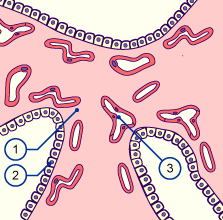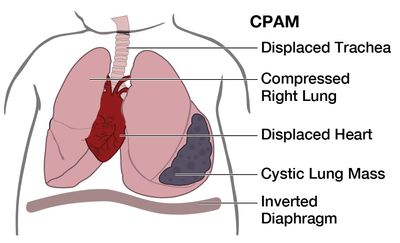Pulmonary Embryology
Pulmonary Embryology
Origin of the Respiratory Tract
The respiratory tract is derived from the foregut endoderm and associated mesoderm.
Lateral Folding and Cranio-Caudal Folding
Lateral Folding: - During lateral folding, the lateral sides of the embryo curve towards the midline, enclosing the intraembryonic coelom. - This process forms the gut tube suspended by the dorsal mesentery.
Cranio-Caudal Folding: - The cranio-caudal folding results in the formation of the head and tail regions of the embryo, which further defines the embryonic body cavities.
Differentiation of the Respiratory Tract
From the endoderm, the epithelial lining of the trachea, larynx, bronchi, and alveoli is derived.
From the splanchnic mesoderm, the cartilage, muscle, and connective tissue of the tract, as well as the visceral pleura, are derived.
Lung Bud Formation
- During the 4th week of development, the lung buds form as the respiratory diverticulum, a ventral outgrowth of the foregut endoderm.
- This process is mesoderm-dependent, involving retinoic acid produced by adjacent mesoderm inducing TBX4 expression in the foregut endoderm.
- TBX4 induces the growth and differentiation of the trachea and lungs.
Tracheoesophageal Abnormalities
Tracheoesophageal Ridge and Fistulas
- The foregut undergoes longitudinal ridging forming the tracheoesophageal ridges that eventually fuse to separate the trachea from the esophagus.
- Incomplete separation or atresia can lead to tracheoesophageal fistulas and esophageal atresia, characterized by an abnormal connection between the trachea and esophagus.
- This defect is commonly associated with other defects involving mesoderm like VATER/VACTERL syndrome.

VATER Syndromes: - Vertebral anomalies, Anal atresia, Tracheoesophageal fistula, Esophageal atresia, Renal atresia.
VACTERL Syndrome: - VATER plus Cardiac defects & Limb defects.
Clinical Correlation: - Complications include polyhydramnios prenatally and postnatal gastrointestinal and respiratory issues such as immediate regurgitation of milk and potential for pneumonia. - Surgical repair is possible with an 85% survival rate.
Formation of the Pleural Membrane and Diaphragm
Pleural Membrane Differentiation
- The lung buds punch into the visceral mesoderm, developing the visceral pleura.
- The somatic mesoderm becomes the parietal pleura.
- The resultant space between them is the pleural cavity.

Clinical Correlation: - Congenital diaphragmatic hernia (CDH) can arise from failure in the closure of the pleuroperitoneal membranes, leading to pulmonary hypoplasia due to herniated abdominal contents interfering with lung development. - Symptoms include poor lung development and potential lung hypoplasia.
Stages of Lung Development
Embryonic Stage (Weeks 4-7): - Lung bud forms and differentiates into trachea, bronchial buds, mainstem bronchi, secondary bronchi, and tertiary bronchi.
Pseudoglandular Stage (Weeks 5-17):
- Endodermal tubules form terminal bronchioles surrounded by a modest capillary network.
Canalicular Stage (Weeks 16-25): - Differentiation into terminal bronchioles, respiratory bronchioles, and alveolar ducts with a prominent capillary network.
Saccular Stage (Weeks 26-birth): - Formation of alveolar ducts and terminal sacs. Pneumocytes develop.
Alveolar Stage (Weeks 36-8 years): - Terminal sacs develop into adult alveoli; from ~50 million at birth to ~350 million by age 8.
Congenital Pulmonary Anomalies
Lung Hypoplasia
- Poor lung development often due to congenital diaphragmatic hernia.

Agenesis of the Lungs
- Can occur unilaterally or bilaterally, most commonly due to the failure of the respiratory bud to develop.
- Unilateral lung agenesis is compatible with life as the remaining lung compensates.
Ectopic Lung Lobes
- Ectopic lung lobes arise from abnormal extra respiratory buds and often lack significant functional implications.
Congenital Cysts of the Lungs
- Result from abnormal budding of the foregut and dilation of terminal or larger bronchi.
- Can cause airway compression and frequent infections if they do not drain properly.

Importance of Prenatal Breathing Movements
- Fetal breathing movements condition the respiratory muscles and stimulate lung development, which is essential for normal lung development.
Lungs at Birth: - Lungs are half-filled with fluid derived from the amniotic fluid and the lungs & tracheal glands. This fluid is cleared by the pressure during delivery, pulmonary capillary absorption, and lymphatics.
Respiratory Distress Syndrome (RDS)
Surfactant: - Surfactant, produced by Type II pneumocytes, is critical for reducing surface tension and preventing alveolar collapse.
RDS Risk Factors:
- Prematurity, maternal diabetes (due to increased fetal insulin), and cesarean delivery (decreased release of fetal glucocorticoids).
- Insufficient surfactant leads to respiratory distress syndrome, a common cause of death in premature infants.
Recent Advancements: - Development of artificial surfactant and glucocorticoid treatments have significantly improved outcomes.
Clinical Insights: - Symptoms of RDS in COVID-19 patients are similar to neonatal RDS, with clinical trials underway for pulmonary surfactants in COVID-19 treatment.